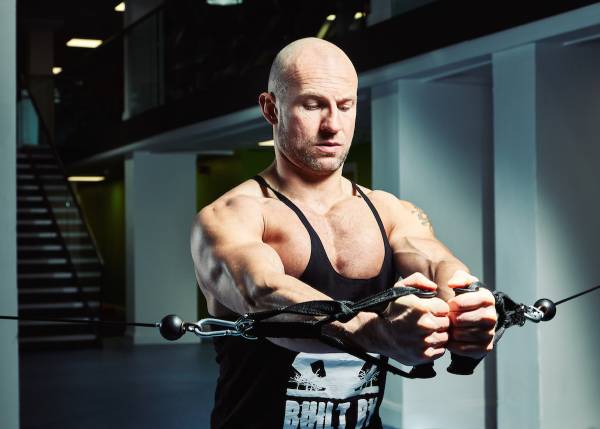In my prior article Society Is Aging Us Prematurely, I made the point that unless you want to follow the masses down a path to early aging, reduced physical performance, and chronic disease, you need to set a different path from the rest of society. Exercise is the key to staying fit and healthy for your whole life, and there’s an army of health and fitness professionals ready to help you with your goals, so it should be straightforward, right? Unfortunately, the fitness industry, like society itself, is a little bit broken. There are plenty of professionals with the necessary skills, but as things stand the system just isn’t working as well as it should.
I’ll relate my own experiences to reveal what I think are the main problems, and then we’ll hear from Eric Pawlikowski, a personal trainer with whom I’ve had good results, to get the insider’s view.
The Problem with Short-Term Thinking
When I first got into training I spared little thought towards maintaining fitness for a lifetime. Everything I did was about short-term goals, and I wasn’t interested in what might happen to me when I was 40, let alone even older than that. I think it’s common for young adults to feel that way.
My training changed as I aged, but always in an adhoc way. New exercise trends would appear from time to time, and I’d try some of them, perhaps adding them to my repertoire if I thought they’d help with my current goal or if I just happened to like them. It didn’t really matter what I did or didn’t do; my body just seemed to handle it and keep on trucking.
Other people in their twenties were the same, and I can see that nothing has really changed. They’ll dabble in the latest exercise crazes that come around, be that martial arts, team sports, running, Crossfit, and so on. If they pick up a sport-related injury and see a physical therapist, something of what they’re told will be added into the mix. Maybe they’ll have a run of sessions with a personal trainer, or read some fitness articles, and that will be added to the other influences on their training, but throughout it all there’ll be no coherent long training term plan. This seems to be consequence-free at first, but the older we get, the more all this adhoc training starts to catch up with us.
Each time we throw ourselves into an activity hard enough and for long enough, we adapt to it, and that adaptation leads to muscle imbalances. Sometimes these can balance themselves out; like a drunk driving a car, you might not hold a straight line but if each swerve to one side is countered by a swerve to the other, you should at least stay on the road.
More often, however, the effects are cumulative and eventually a breaking point is reached; injuries begin to stack up and everything gets harder than it used to be. For many people this coincides with crossing an age boundary; they blame their age for their condition, and society backs them up. The majority step away from an active life at this point, and the few that persist often continue in a haphazard way, perhaps switching to other activities that they can still manage to do.
In my case, the result of all my pseudo-random training was a seized hip and an osteoarthritis diagnosis, and it was this shock that finally taught me that training without a well-considered long term plan is not sustainable. If this realization is shared by the health and fitness industry, there’s no sign of it.

A Renovation Project That Lasts a Lifetime
If you liken a body thrown out of balance by indiscriminate training and lifestyle choices to a house marred by ill-planned extensions, changes, and bodged repairs, you’re now facing what could be called a major renovation project. This is a popular subject for TV programs, and one thing they all agree on is that you can’t undertake such a project without employing at least some professional help. Your house has gone from being a well understood and regulation-compliant new build to being an ailing, one-of-a-kind variant that needs expert attention. What’s more, that attention had better be closely managed or you’ll burn through your budget and your house will still need fixing.
Similarly, few people are capable of fixing 30 years or more of abuse and imbalances without professional help. As with tradesmen, this help will come from people with particular specialities and skills, and must be carefully project-managed in order to get a consistent and desirable result.
This is exactly what I tried to do when I consulted professionals to help me address my own imbalances. What I experienced has been echoed by people from around the world who contacted me after buying my self-help book on beating osteoarthritis. My input was largely disregarded; the pros insisted on going back to square one, slowly discovering the things I already knew and had tried to tell them. When they eventually caught up with me, they proved incapable of taking things forward because my situation was too far removed from the simple, common cases they were equipped to handle.
In short, the pros don’t like being project managed, and they target their solutions for the most common cases. Their first instinct is to take control and work through things in their own well-practiced way; if your case is anything out of the ordinary, this is unlikely to get you the solution you want. Now all of this is entirely understandable, even forgivable, because with limited resources to spare it makes sense to concentrate on solutions that have the broadest application. Still, this comes as little comfort to those who have their hopes raised by confident promises, pay their money, and come away sorely disappointed.
There Are Lights Along the Path
This left my faith in experts somewhat dented, but some time later I had a more positive experience. I was going through a slump, low on motivation and lacking direction after backing off my training to address yet more imbalances. My gym at the time was run by personal trainers, and over a period of a couple of years I’d gotten to know some of them quite well. One of them, a bodybuilder and calisthenics enthusiast called Eric, seemed like he might be the right trainer at the right time.
His sessions were genuinely helpful, and got me back on track with my training which helped me to resolve numerous longstanding issues. It’s difficult to identify why this course of training was so successful. Much of what I learned could have been self-researched, but without the combination of encouragement, inspiration, technical correction, and exchange of ideas I received, I wouldn’t have made the same progress.
This one successful consultation went some way to restoring my confidence in experts, and proved that good results are possible if you can find the right person, with the right skills, at the right time. After so many failures however, I still see a lot of problems with the fitness (and health) industry as it currently stands and I’m far from convinced that this good experience with Eric is easily repeatable. I know for sure I wouldn’t risk hiring another trainer unless I had the opportunity to get to know the candidates well beforehand and observe them at work. The best recommendation I can give is to find a gym where a number of trainers work openly and just bide your time, using what you see to help make your choice.
The final, and perhaps most important piece of advice I can give from my own experience is to stay in control; never relinquish your position as project manager. A big drawback of seeking professional help is that it feeds the hope that someone can do all the hard work for you—they can’t. The sooner you accept that and take responsibility for your own health and fitness, the sooner you’ll get lasting results. Health and fitness professionals are available to help you, but it’s up to you to manage them wisely.

Fitness Insider’s View – Personal Trainer Eric Pawlikowski
The analogy with the house renovation is great. When Susan came to me, her renovation project was partially complete, as she’d already done a lot of research and work to put right some major structural problems. Even after all that work she was going through a low point, and had lost momentum. Things were starting to slide back into decay.
I saw my first task was being to provide emotional support and a challenging training plan that would reignite her spark of enthusiasm. You could equate this to scaffolding and steel joists in a house. We put our heads together on a few things and came up with new ways of waking up the lazy muscles. I didn’t try to replace and redo all that she’d done, I worked with it, just as anyone should do with a partially renovated period property.
I taught her all the techniques that I used so that she’d be able to carry on progressing herself when our sessions ended. This happened earlier than expected; she had committed to one year of training but at the six-month stage she was expanding and evolving so rapidly that there was no way I was going to keep up with her plans with only one session a week together. She reached the point where she didn’t need my help anymore and that is what you want as a trainer, even though it’s not the best way to make money.
I think the approach I took with Susan is exactly the kind of service an experienced client needs from a personal trainer. I think everyone could benefit from something like this periodically throughout their lives. On your own things can get stale, no matter how skilled or experienced you are. You need an objective second opinion to fix bad habits that have crept in, spot things that are missing, and to inject new ideas and skills that can get you moving forward again.
I agree that the personal trainer model doesn’t consider what happens in 10, 20, or 30 years, because usually you won’t have the same client for that long. Susan’s case gave me a lot of head-scratching and researching, but I enjoyed it, and I believe that’s how we, as professionals, learn and improve.
Problems Within the Fitness Industry
Susan has identified some problems with the fitness industry, but I’d like to outline some additional issues that I see, and I’ll conclude with thoughts on the model that I think helps address these problems.
In the UK there is no official regulation and anyone can become a personal trainer. Qualifications aren’t legally required, and even when they are present, they don’t always mean anything other than the person turned up and paid the necessary fee. Qualifications that are given without being earned can give the public false confidence in a trainer, and they can give the trainer false confidence, too, which is dangerous.
Then there’s the push for client retention. From a financial and workload point of view it’s much better to keep a small group of the same clients for two or three sessions a week for a period of several years than to have a rapid turnover of new clients; you spend less time searching for new clients and getting to know them. That’s why some trainers will try to hold on to a client whether it’s the best for them or not; Google for “client retention” and you’ll see some of the tricks they use.
On the other hand, inexperienced clients really will do best if they stay with a trainer for a long while, as this will hard-wire good form and good training habits for life. If they quit after a shorter period, say just a few months, they’ll slide back to where they started and all that effort and education will have been wasted. Unfortunately, there’s no way for a client to know whether their trainer is trying to keep them for financial reasons, or because it will produce the best long-term result.
There should be a bond of trust between a client and a trainer, but some trainers have a very low ethical standard. If a client opens up about personal problems they may have, for example their insecurities, some trainers use this personal knowledge to maneuver the client into buying more sessions. If a new exercise or diet becomes fashionable, the new trainer may instantly claim expertise whether they have it or not. These people are no better than used car salesmen, and they lower the standing of reputable PTs.
It’s not just bad trainers scamming clients that you need to worry about; other members of the fitness industry lure otherwise well-intentioned, inexperienced trainers into personal training with promises of big money. They sell them courses filled with dubious facts, give them meaningless qualifications. and send them out to spread this misinformation to all their unsuspecting clients. This is how so much trash becomes accepted knowledge.
The end result of all this is that it’s difficult for a PT to make a living ethically. The typical client has absolutely no way of telling the difference between a good trainer and a bad one, sometimes even after having trained with them. The bad ones reflect poorly on everyone in the industry, and once someone has had (or heard of) a bad experience, it’s hard to convince them that things will be different with a good trainer.
This can only be changed through regulation, the establishment of mandatory qualifications that actually mean something, ongoing training to keep everyone to standard, and gyms that provide potential clients the ability to see trainers in action and get to know them before hiring them. It’s not just the cost of a bad fitness pro you need to worry about; it’s a position of extreme trust with the potential to do serious and lasting harm both emotionally and physically.

The Budget Gym Model – A Step in the Right Direction?
In the absence of any national regulation, some gyms are stepping up to raise standards themselves. The gym we used to shoot the photographs for this article, The Gym Group in Glasgow, UK, has its own requirements for all its PTs:
- Minimum qualification of a Level Three Personal Trainer with The Gym Group
- Strict standards and codes of conduct
- Regular top up training (for example, the management might bring in an osteopath to give PTs more in depth understanding of how to help clients with back and joint pain.)
- Discouragement of the ‘hard sell’
- PTs must devote 10 hours per week to running the gym
This model addresses a lot of the current problems while the resident the PTs get to see gym members training, members get to see PTs at work, and the absence of hard sell promotes a friendly, helpful atmosphere that is all about training well and making progress. Even when a client finishes their course of sessions with a trainer, they can still see each other regularly and maintain contact, keeping the door open for working together again further down the line.
Credits
Eric Pawlikowski is an experienced personal trainer and body conditioning consultant, a former martial artist and competitive natural bodybuilder. Eric is passionate about helping people to build strong, functional bodies that look amazing. Eric can be contacted via his website.
The photos in this article were taken at The Gym, Bothwell St. Glasgow. The Gym Group has branches throughout the UK and are open 24 hours a day with state of the art equipment, no contracts, no joining fees, and low monthly fees.






